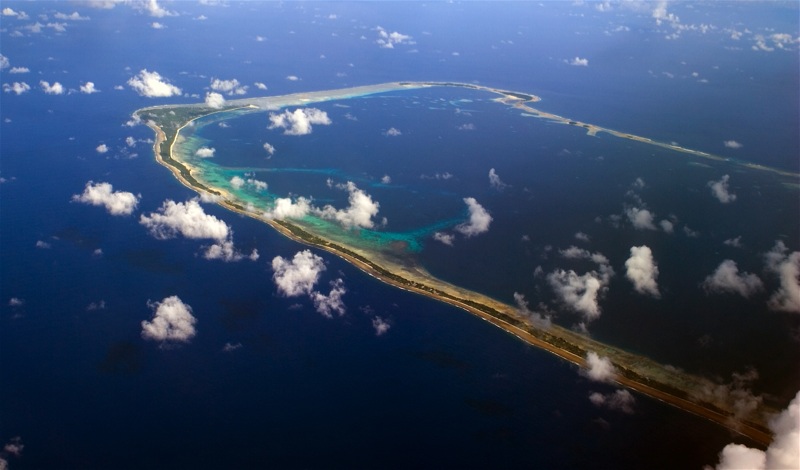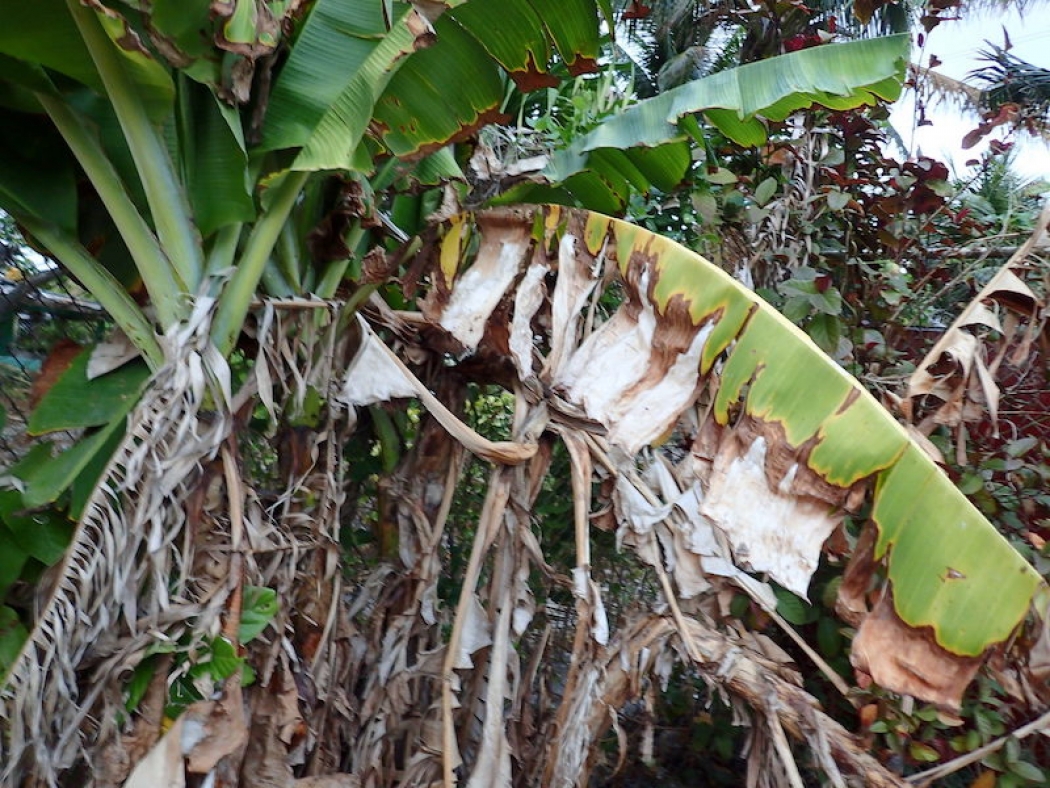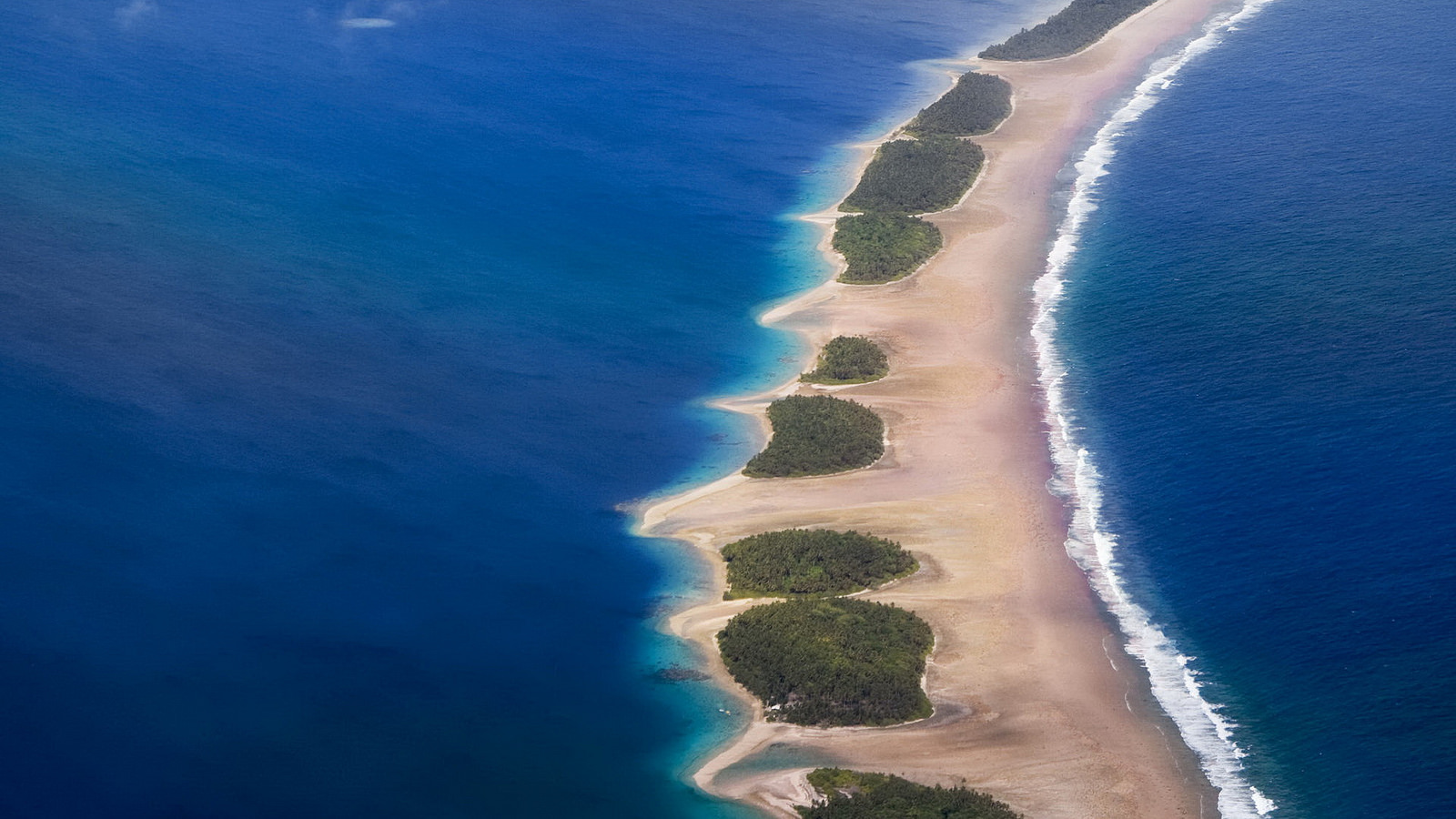From the vantage point of a boat bobbing on the deep blue waters of Majuro Lagoon, the encircling shores of the Pacific coral atoll are normally verdant with tropical vegetation. But on a recent sailing excursion with friends, Angela Saunders was struck by how brown and withered the island looked.
“The vibrant color of all the trees was gone,” Saunders, a Majuro-based program manager with the International Organization for Migration, wrote in an email. “It was like someone put dampers on the world.”

Majuro, capital of the Marshall Islands, is an atoll in the Pacific Ocean with a land area of about four square miles. It is home to about 30,000 people.Christopher Michel
It is a scene that is playing out across the hundreds of low-lying islands and atolls scattered across a vast swath of the western Pacific Ocean broadly known as Micronesia. One of the strongest El Niños on record has curtailed the rains that are the lifeblood of most of the region’s communities and ushered in an extreme drought that has left inhabitants in a precarious situation.
Wells have become brackish or run dry; the rain barrels that perch on the corners of houses have little or no rainwater left in them. Water rationing is limited to a couple of hours a day in some of the worst-hit communities, while expensive reverse-osmosis machines have been shipped out to the most far-flung atolls to make the seawater drinkable. Staple foods like breadfruit and bananas have shriveled on the trees, inedible.
Worries over acute food and water shortages, as well as the spread of disease, have prompted several of the affected island nations to issue disaster declarations in order to receive assistance from the United States and other countries.
“Drought in the U.S. is kind of an inconvenience … but out here it’s a life-or-death kind of situation,” Chip Guard, a meteorologist with the main regional U.S. National Weather Service office in Guam, said.
While El Niño is waning, it will be weeks or months before the rains gradually return to normal levels. Even then, it will take time for crops, rain catchments, and groundwater levels to recover, continuing the strain on locals well into the summer.
“Every day longer the drought lasts, the more you hear about it,” Saunders said. “In the store, on the streets.”
El Niño effects
El Niño tends to dry out the islands of Micronesia because it shifts the main area of storm activity in the tropical Pacific eastward and away from the region, following the commensurate eastward displacement of the pool of warm waters that fuel those storms.
The western- and northern-most islands tend to fall into drought first, following the gradual eastward migration of the rains, and stay in drought longer. Palau, the westernmost island chain in the region, to the southeast of the Philippines, was the first to enter into drought conditions last year. As of an April 28 update from the National Weather Service, it was in an exceptional drought, the highest level. Koror, its most populous state, had its driest October through March on record, as did Majuro, the capital of the Marshall Islands, and Yap State, in the Federated States of Micronesia.
While some places have had spotty showers that have provided sporadic, temporary relief, others have fared worse. In February, Richard Heim, a meteorologist with the U.S. National Centers for Environmental Information, rattled off the rainfall record for Wotje, a hard-hit atoll to the north of Majuro: “Zero, zero, zero, trace, zero, zero … They are getting nothing,” he said.
Although the relationship between El Niño and drought in these islands is well known — which helps governments and aid agencies to forecast and prepare in advance — it is unclear how global warming might alter the El Niño phenomenon in the future.
[protected-iframe id=”3af1bc02276f0e87acf554d1cf709536-5104299-15574887″ info=”https://www.climatecentral.org/wgts/el-nino-impacts/index.html?utm_source=grist&utm_medium=embed&utm_campaign=2016ElNinoImpacts” width=”660″ height=”523″ frameborder=”0″ scrolling=”no”]
The effects of climate change are of acute concern to island residents, as rising sea levels already eat away at what little land they have and threaten water supplies as overwashing waves that can make groundwater brackish become more common.
While rainfall is overall expected to increase across Micronesia as the planet warms, according to a 2014 report by an Australian-led project looking at climate change projections in the region, that increase is somewhat uncertain. And it is the variability of rainfall, not average rains, that is the main driver of drought there, Sugata Narsey, one of the coauthors of that report and a climate researcher at Monash University, said.
The main source of variability there is El Niño, he said. Some research has suggested that warming could mean more frequent extreme El Niño events, but the link isn’t yet conclusive.
When drought does occur in the future, it is possible it could last longer because evaporation will also increase with warming, Michael Grose, a climate researcher with Australia’s Commonwealth Scientific and Industrial Research Organization, said. This is one of the ways climate change exacerbated the current drought in California.
Surrounded by water, but none to drink
It is a cruel irony that, though surrounded by the vast expanse of the largest ocean on the planet, the islands and atolls of Micronesia can run out of drinkable water.
Except for some of the larger islands in the region, such as Guam, most don’t have reservoirs to keep water supplies steady and on hand for lean times. (And even those that do have them are seeing well below-normal levels.)

The region of the Pacific Ocean known as Micronesia.Wikimedia Commons
Instead, most of the region relies on the near-daily rains of the tropics to maintain the groundwater supplies that feed wells and are caught by the green, high-density plastic rain catchments attached to many homes. But a certain minimum threshold of rain — usually about four to eight inches a month — is needed to maintain viable water supplies. Below that level, drought can set in, and quickly.
“The atolls especially are very susceptible to drought,” Guard said, because they are too low-lying to have significant underground aquifers.
For those islands that do have wells, the water inside can quickly become brackish during a drought. As freshwater is extracted, the seawater below it creeps upward, Heim said. One day the well water is drinkable, the next it turns salty. That leaves a tight window for relief agencies to bring water or reverse-osmosis machines to distant atolls a full day’s boat ride from the main islands. These outlying atolls also often lack internet and cellular service, making quick communication a challenge.
“Really a struggle”
When visiting the outer atolls of the Marshall Islands, Saunders, of the IOM, said that as soon as you walk off the plane, “you notice the heat more. There is less shade to sit under and you can really imagine how hard life is for those most affected” by the drought.
The Marshall Islands have been hit particularly hard because virtually all of the nation’s land is low-lying. Of those islands that do have wells, many were too salty to use by early March. Many rain catchments had also run dry by that point.

Dried vegetation on Majuro.Karl Fellenius/University of Hawaii Sea Grant at the College of the Marshall Islands
“Not everyone’s water is totally out, but some are, and everyone is conserving,” Saunders said.
On Majuro, there are 19 water distribution points and a reverse-osmosis machine that generates 25 gallons of potable water a minute and runs 24 hours a day at the College of the Marshall Islands. Island residents have access to tap water for only four hours a week, according to the Marshall Islands Journal. On the outer islands, 32 reverse-osmosis units have been deployed.
“This means that people have to walk to these spots to get water, or if they can, take a car or a pushcart to carry water,” Saunders said.
Each nation has limited resources and it is “really a struggle to respond,” Guard said, which is why aid from the United States and agencies like the Red Cross is critical. The Marshall Islands, the Federated States of Micronesia and Palau have all declared states of emergency or disaster to enable that aid, and last week, President Obama declared a state of disaster for the Marshall Islands, allowing for FEMA support. The IOM has helped provide reverse-osmosis units, collapsible jerry cans, and soap to residents.
As ground and surface water have dried up, so have key food crops. Staple food sources like taro, breadfruit, banana, and coconut “are for the most part no longer edible,” Guard said in an email. This makes food security a critical issue, especially for outlying islands.
The spread of social diseases like conjunctivitis has also been a concern, as people conserve what little water they have for drinking and cooking at the expense of hygiene. Advisories have also been put out in some locations to boil water in order to prevent the spread of gastro-intestinal illnesses.
Such precautions will likely remain in place for several weeks or months to come, because while El Niño is petering out, rains are expected to stay below normal through the late spring and early summer. But gradually, El Niño’s grip will weaken, and the rains will slowly return from south to north, east to west, reversing their disappearance of several months ago.
But even when the rains do return, it will take time for catchments, groundwater and crops to recover. And that return is not without its own problems — the mosquitoes that spread diseases like dengue fever and Zika virus tend to be more widespread after a major drought, Guard said.
These hardships are something that the people of the region are accustomed to, though, and they have pulled through similarly deep droughts in the recent past.
“The Marshallese are extremely resilient people — that is how they have survived for thousands of years on these small islands,” Saunders said. “They cope, they manage, but it is not easy.”



